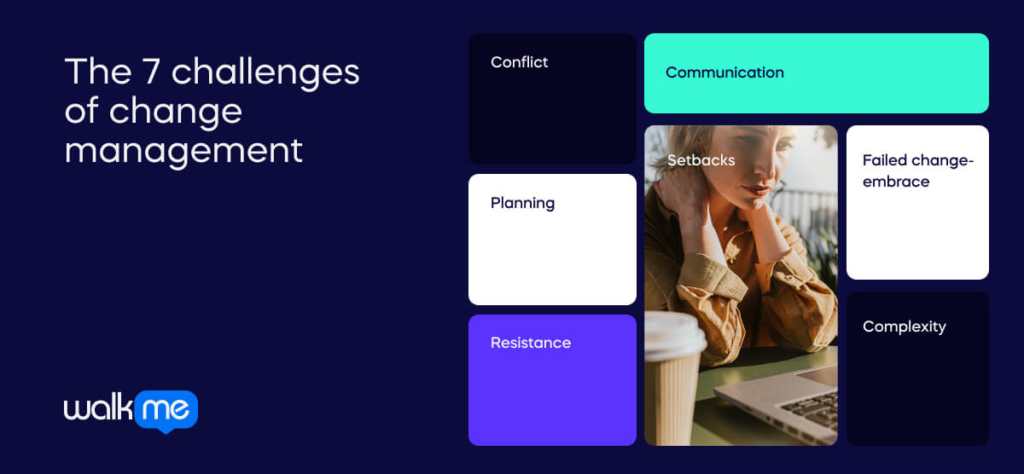Let’s get this out the way for starters: You will fail any digital transformation if you don’t defeat all the challenges of change management.
Your staff needs the management team’s support to get them through the complexity and emotional challenge of change initiatives.
Avoid joining one of three CEOs who fail to achieve their desired outcome for digital transformation initiatives. Tackle change management challenges before implementing your changes.
To help you defeat the challenges of change management, we will explore the following topics:
- Why is change management challenging?
- What are the 7 challenges of change management?
- Strategies to defeat the challenges of change management
Why is change management challenging?
Before you consider how to defeat each challenge of change management, think about why change management, the act of supporting employees to deal with change from the status quo, is challenging.
Change management is challenging because enterprises need change, and employees usually don’t feel they need to change.
Therefore, you must meet your employees halfway and ensure you present the need for change to them in a way they understand and can see that change will benefit the company and their roles.
What are the 7 challenges of change management?

Knowing the seven challenges of change management will help you move through them to prepare for a successful outcome for your change strategy, ensuring you have the right resources and attitude to begin driving successful change.
1. Conflict
Change can evoke emotions like uncertainty and fear, leaving staff to take their frustrations out on each other. Conflict is a common unintended consequence, so your leader must help staff overcome difficulties.
Conflicts will disrupt your schedule, so you must intervene and mitigate issues whenever possible, which is why conflict is one of the most common change management challenges.
How to defeat it
Be alert to proactively tackle the issue’s root and find a solution incorporating staff input through feedback collection, analysis, and a robust way of visibly acting on the feedback.
2. Planning
Change will fall by the wayside without correct planning.
You’ll reap the benefits of a systematic procedure, which underlines the exact nature of changes and what needs to happen for these changes to stick.
For example, suppose you’re introducing a new system. In that case, you’ll need to appreciate whether it’s compatible with the old system and how you will transfer essential information as you transition.
How to defeat it
Successful planning involves delegation to maximize staff potential and ultimately increase efficiency.
With all duties covered, you can create a successful timeline for change, which accounts for downtime and unintended consequences.
3. Setbacks
Setbacks are inevitable, but you can reduce their impact by identifying them before they happen.
Never presume your steps towards change will be flawless. Your method won’t be foolproof, and it’s difficult to foresee the future accurately.
How to defeat it
When something goes wrong, maintain a positive attitude, implementing measures to prevent recurrences. If your team pitches in to help, the delay will shorten considerably.
Expecting setbacks is one thing, but identifying challenges will ensure you’re well-prepared.
When a challenge surfaces, you can assess whether it’s a one-off or a critical outcome that requires reshaping your change process.
4. Communication
A failure to communicate intended changes can break your run of success.
Speculation and rumors will sweep your organization, and a lack of trust will make it difficult for staff to embrace change, especially when they’re uninformed about what’s required from them.
Employees need to know what’s happening because uncertainty will disrupt your workforce. They should understand planned updates. Otherwise, they’ll be less aligned with your objectives and feel disconnected.
How to defeat it
Keep employees up-to-speed, whether you coordinate regular meetings or set up brainstorming sessions within a focused communication strategy for all change efforts.
Communication should be two-way because staff can help you change procedures with valuable ideas, aiding continuous process improvement.
5. Resistance
People naturally resist change because we grow accustomed to the security our current circumstances offer.
However, there’s no room for future growth when we get too comfortable in the present.
How to defeat it
Resistance must be addressed psychologically, with understanding, feedback, and strong communication to break down behavioral barriers that restrict our evolution.
Emphasize the benefits of change to ease a transition into the future by empathizing with staff concerns, visibly acting on them, and reassuring them that change will not have the negative consequences they expect.
6. Failed change-embrace
Initiating a plan of action is great, but it’s useless if staff don’t fully commit to your plans.
Encourage your organizational embrace of new philosophies to break down the barriers set up during the process.
How to defeat it
Decision-making starts at the top, but the attitude to change needs consistency. Set the precedent as a leader, and your willingness to change will trickle down.
Everyone needs to be on board, from management to remedial staff. Otherwise, you risk facing resistance at every level.
Change is imminent, but adapting to change is eternal. As a leader, set an example with your organizational change management, and your staff will follow.
7. Complexity
Every change management process is complex.
Competing key stakeholders present different needs and challenges, which muddy the waters, delay change, and increase the emotional strain on staff, which can lead to burnout and failure.
How to defeat it
The complexity of change can often fall under the radar as one of its main challenges, so always have this challenge in the back of your mind when considering what is not going to plan.
At every stage, try to break up the change effort into smaller actions so it is easy to be methodical and trace back to failures to adjust, review, and progress with a renewed sense of purpose for the organization.
Use a DAP to defeat the challenges of change management
Navigating the labyrinth of change management demands a strategic approach.
Amidst the hurdles of change fatigue and organizational transformation, the key lies in continuous improvement afforded by a digital adoption platform (DAP).
A successful change initiative hinges on adeptly managing change, treating it not as an isolated event but as a dynamic process, which a DAP facilitates through in-app guidance and tailored learning, allowing your staff to understand they should embrace and not resist change.
A well-executed change management project is the linchpin for organizational evolution.
Acknowledging the challenges, understanding the nuances, and embracing continuous improvement can pave the way for a triumphant journey through the intricate terrain of managing change.

